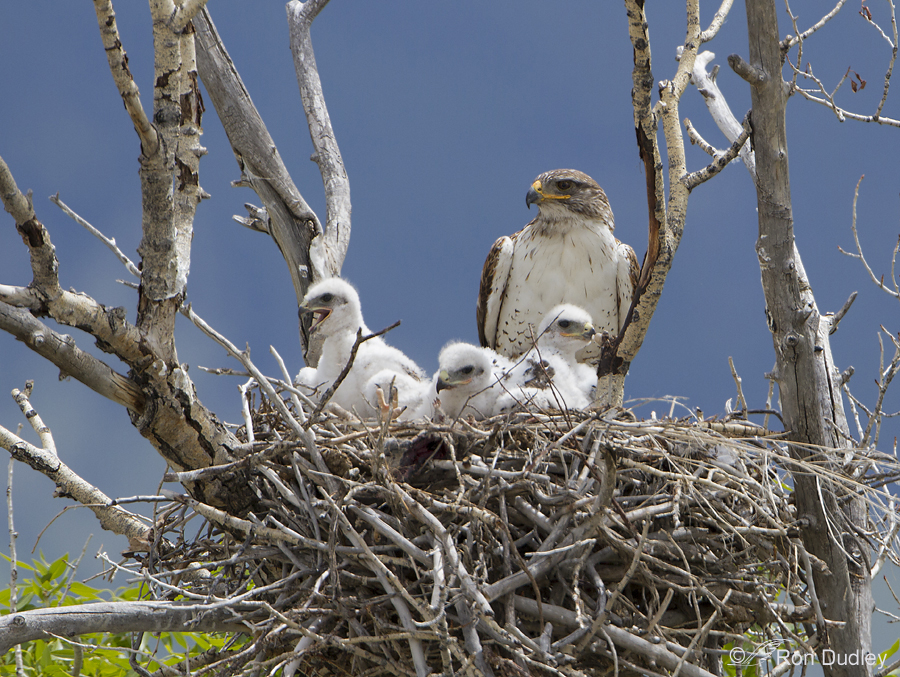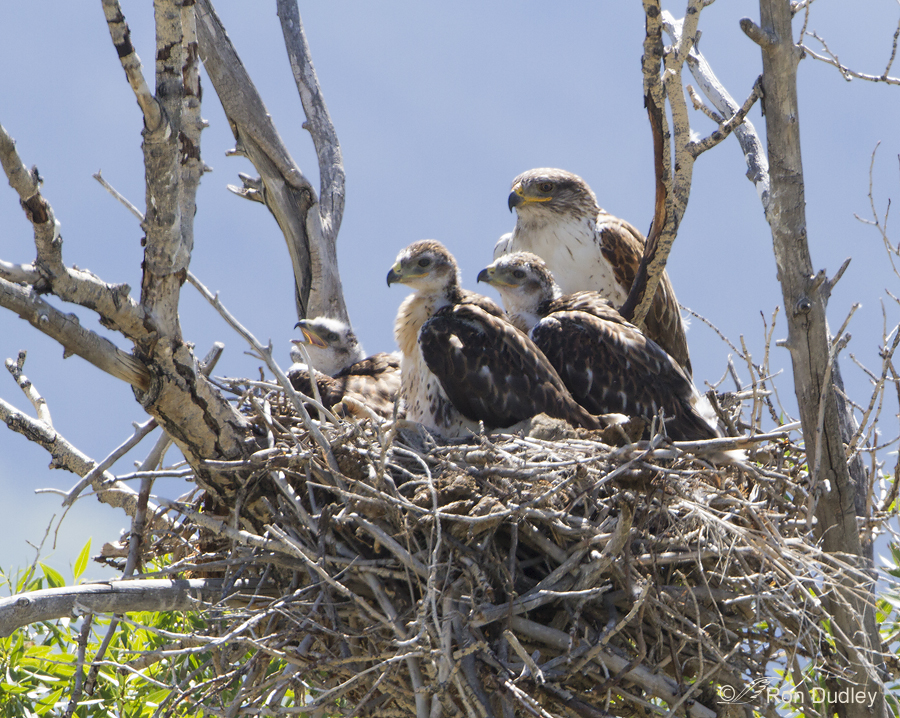We arrived home from our latest foray into western Montana yesterday afternoon – earlier than planned due to uncooperative weather and (to some extent) birds. Those issues are just part of the game when you’re a bird photographer but I’m sure we’ll try again several more times this summer and early fall. We still had a great time, saw some wonderful new and wild country, reacquainted with an old friend (and met a new one who now lives in Alaska but graduated from the same Salt Lake City High School where I was a teacher for 18 years – small world!) and reveled as we always do in our time spent in Big Sky Country. And I did get a few shots that I like that I’ll be posting soon.
This post is for documentary purposes only – no aesthetics involved.
In a completely unplanned manner (long story) we ended up spending a few minutes at the Ferruginous Hawk nest that I posted about here from our last Montana trip. I thought some of you might like to see how the chicks are coming along.
This is one of the images from that earlier post – taken on June 6, 2013.
Here are the same birds 12 days later, June 18, 2003. As you can see, the kids are growing up – and quickly!
We had no choice but to be there at mid-day so the birds are side lit by very harsh light but I still think the comparison between the two images gives the viewer a good idea of how much development occurs in less than two weeks.
The Ferruginous Hawk news from this part of the state is disheartening. I learned that the number of nesting pairs of Ferruginous Hawks in the area has declined sharply over recent years. One very knowledgeable gentleman that we talked to was absolutely delighted that we had found this nest on our previous trip and said that it is likely the only active Ferrug nest in the entire area this year, after much greater nesting activity by the species in previous decades.
Sad news indeed.
Ron
Note: Both nests referred to in this post were very close to roads. I photographed the nests from those roads and from inside my vehicle. The birds were acclimated to vehicles and traffic and were not disturbed.




Although total Ferruginous Hawk numbers in the west desert of Utah are low relative to populations in MT, they seem to be enjoying increasing nesting success here. Some speculate it’s due to the decline of the Golden Eagle, a common predator of ferruge nestlings.
Hi Ron, Thank you for this “documentation”. Although you said “no aesthetics involved”, I believe you have captured the beauty of these birds perfectly. BTW, I discovered a Ferruginous Hawk nest a few weeks ago – I couldn’t (and wouldn’t) count the number of youngsters because to do so would have been to get too close. As you might know, ferrugies will abandon the nest if disturbed early in the nesting cycle. I observed the nest through my scope from approx 1/4 mile. Thanks again for sharing!
I’m delighted that you found a Ferrug nest, Dick – the more the better. And yes, I’m well aware of the sensitivities of this species in particular, especially early on in nesting. That’s why I’m a little surprised they chose to nest so close to the road. It’s actually a highway with heavy traffic, including lots of noisy trucks. They were so loud they irritated me in the short time I was there photographing these birds.
A-W-W-W.
Thank you. Wonderful pictures.
How wonderful to see the changes in those birds. It is really fun getting to watch them develop.
Thank you, Susan.
It is amazing just how fast they are growing. Amazing – and wonderful. Thank you so much. And SIX more is great news.
The six chicks are badly needed, Elephant’s Child. I think we all hope that all of them thrive.
WOW!!!! What a difference 12 days makes!!! They are GORGEOUS!!
They grow fast, Nicole. Very fast.
What a beautiful, regal family! Thanks for documenting and sharing.
Glad you like it, Tana. Regal is certainly the right word.
@48dodger
You can get that kind of information from ebird at http://ebird.org/content/ebird/. Click on the Explore Data tab. The line graph is probably what you want. If you click on the map you can see where they have been reported. You don’t need to have an account for this.
Thanks, John. That’s a great resource.
Awesome site John, Thanks!
I made an account and have begun my entries.
Tim
Not sure about the Ferruginous Hawks, but most Red-Tails are flying from 50-60 days after crackin the shell. Interestingly enough, city RTs take a bit longer fly. My guess is they start from a ledge, no branches for hopping practice. The Fergi’s(my nickname for’em) in our neck of the woods(Camanche Lake, Ca), get a lot of help from the power company in the way of large nest perches on the telephone poles. I’d be interested know how the numbers are around here.
I love these two images! You’ve shown their impressive ability to blend into their home….something I’m glad I don’t have to do.
I look terrible in tan lapsiding and stucco.
Tim
Tim, BNA says that Ferrugs “typically first leave the nest at 38–50 days; males (smaller in size) leave as much as 10 days before females”. But perhaps “leave the nest” doesn’t yet mean flying – maybe they’re simply negotiating the nest tree.
The books I have on Red-Tails state 52-59 days to fledging (flown at least once). I, of course rounded off those numbers. But interestingly enough, one of the hawkcam websites I watch has had their chicks flying at 42 days (its a college cam, what do you expect, overachievers! lol). So I think I’ll just say 45 days now, if asked…sounds like a good middle ground.
Tim
Beautiful Family Portraits Ron !
Thank you, John.
Wow – what a change! I have to wonder if it is the same chick in both pictures in the far left, looking left and apparently having something to say, or yawning. Thanks for giving us another look!
It sure could be the same chick, Leisa. I believe it was ventilating in that shot – it was fairly warm at the time.
Fantastic shots and a hopefully good brood that will all fledge! Thanks for sharing your amazing shots Ron!
Thanks, Charlotte. It looks promising for these three chicks to make it to fledging as it does for the slightly younger three chicks in the other nest. That’s potentially six more Ferrugs so I definitely have my fingers crossed for all of them.